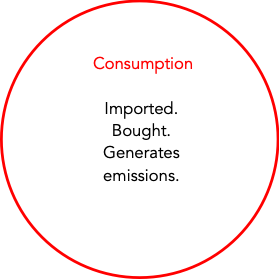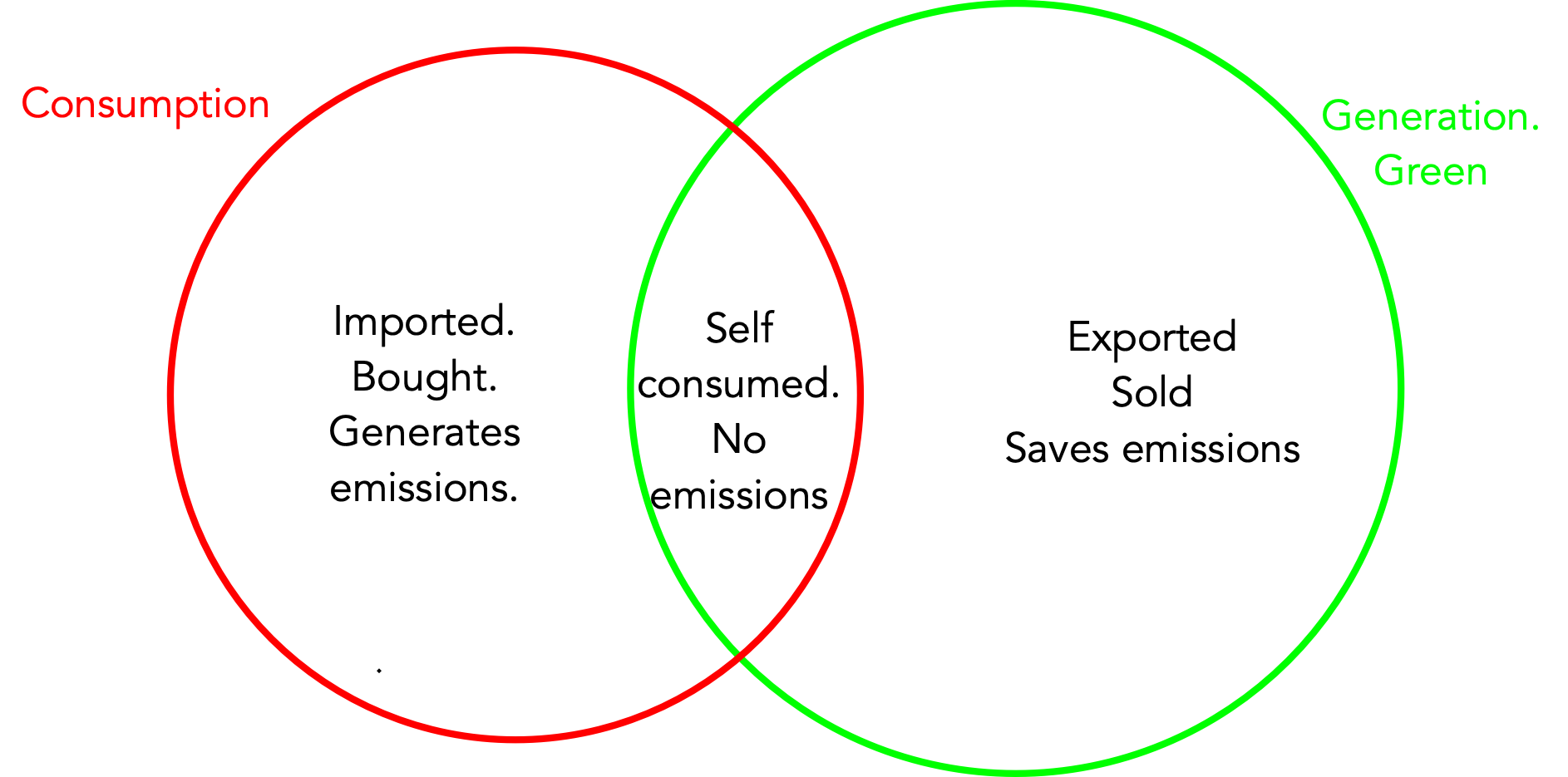|
Size: 5478
Comment: With extreme cases added. Not sure I like it.
|
Size: 5644
Comment:
|
| Deletions are marked like this. | Additions are marked like this. |
| Line 8: | Line 8: |
| ||{{attachment:WithBattery.png| |height=200}} ||Installing a battery does not change the energy consumed, i.e.the size of the red circle, nor the energy generated, the size of the green circle.<<BR>>What it does change is the level of overlap. It increases self consumption by allowing some of what would otherwise have been exported, to be stored and used when instantaneous generation is less than consumption, e.g. at night.<<BR>>This means that both export and import are reduced by the same amount, equal to the increase in self consumption.<<BR>>Import and export have different prices but the same emissions intensity, so that a battery saves money but not emissions. || ||{{attachment:OffGrid.png| |height=200}}||The extreme case where consumption never exceeds generation and battery output.<<BR>>This is not achievable in Melbourne for any realistic size of battery.<<BR>>Imports have now shrunk to zero, and exports have also shrunk by the same amount|| |
||{{attachment:WithBattery.png| |height=200}} ||Installing a battery does not change the energy consumed, i.e.the size of the red circle, nor the energy generated, the size of the green circle.<<BR>>What it does change is the level of overlap. It increases self consumption by allowing some of what would otherwise have been exported, to be stored and used when instantaneous generation is less than consumption, e.g. at night.<<BR>>A battery can be seen as time shifting generation, without changing the amount.<<BR>>This means that both export and import are reduced by the same amount, equal to the increase in self consumption.<<BR>>Import and export have different prices but the same emissions intensity, so that a battery saves money but not emissions. || ||{{attachment:OffGrid.png| |height=200}}||The extreme case where consumption never exceeds generation and battery output.<<BR>>This is not achievable in Melbourne for any realistic size of battery.<<BR>>Imports would shrunk to zero, and exports would also shrink by the same amount. Going off grid would prevent export, and reduce generation to match consumption.|| |
Link to > FurtherEmissionsReduction2024 >
The effect on emissions of adding batteries to a solar system
|
The red circle represents the total energy consumed over some time interval. |
|
Installing PV panels is represented by the green circle, the emissions free energy generated over the same time. |
|
Installing a battery does not change the energy consumed, i.e.the size of the red circle, nor the energy generated, the size of the green circle. |
|
The extreme case where consumption never exceeds generation and battery output. |
Notes
Adding the battery will actually increase consumption slightly as charging and discharging cause some losses as heat. See here.
The tradable carbon credits for the saved emissions due to exported energy will be counted by the power company if they were signed over at installation, as is very common.
- Emissions are logically proportional to the difference between Consumption and Generation, neither of which change. This is the same as Bought minus Sold, as self consumption neither causes nor displaces grid generation, and Bought and Sold change by equal and opposite amounts.
- Increasing self consumption in other ways, such as time shifting loads, have the same effect.
- Widespread batteries do facilitate decarbonisation of the grid by reducing the variations in demand.
Batteries do decrease the likelihood of the power company reducing the output of inverters to stabilise the grid. Such reductions of solar generation would increase emissions as long as the grid retains fossil fuelled generation.
WarrenGreenwood added:
Sorry David, but the argument in the second layer box, that is the overlap, is invalid. The export and import does not remain the same as domestic inverters have an artificial 5kWh export limit to the grid, even if they are capable of more and irrespective of the total import. The church inverters have 3 x 10 kWh or 30 kWh limit. If a domestic solar array generates (say 8 kWh) then all 8 kWh goes to a battery whereas only 5 kWh goes to the grid. So no, I do not agree with your conclusion. I also feel that Carbon Credits do not change the equation, they only allow the holder to offset the actual. Reducing overall demnd even by adjusting time based using, will reduce emissions. The carbon credit process does not reduce overall emissions in the community. WarrenGreenwood
DavidMorgan replied:
A battery can reduce the already very slight risk of export limiting in new and changed systems, but not ours.
As you have yourself said, we are not subject to export limits, and will not be unless we change the system.
Furthermore the export limits on new and changed systems are no longer 5kW but 10kW per phase most of the time, from last month.
For the evidence, see https://www.solarquotes.com.au/blog/dynamic-solar-exports-victoria/
Including: "The statistical spread based on data collected in the trial shows that, on average, devices were able to export at 10kW or their inverter capacity for 99.4% of the time, far exceeding the 98% target.” This is for new dynamic export limited systems.
The losses in charging and discharging a battery far exceed any reduction of export limiting. The Glen Waverley Uniting Church PSALTER
The Glen Waverley Uniting Church PSALTER


